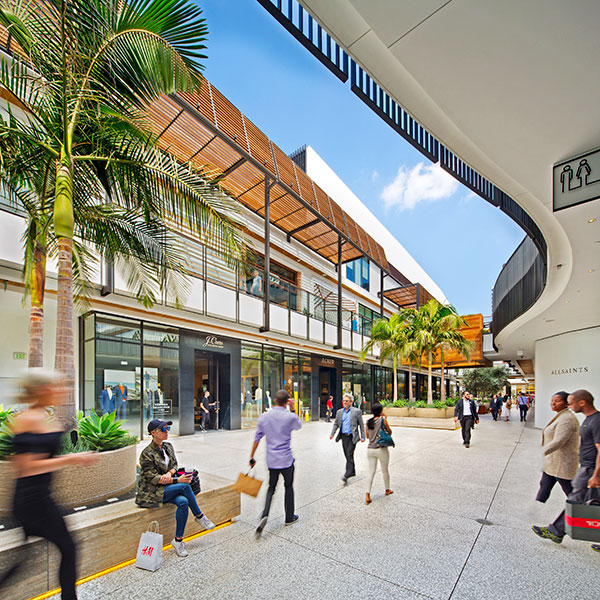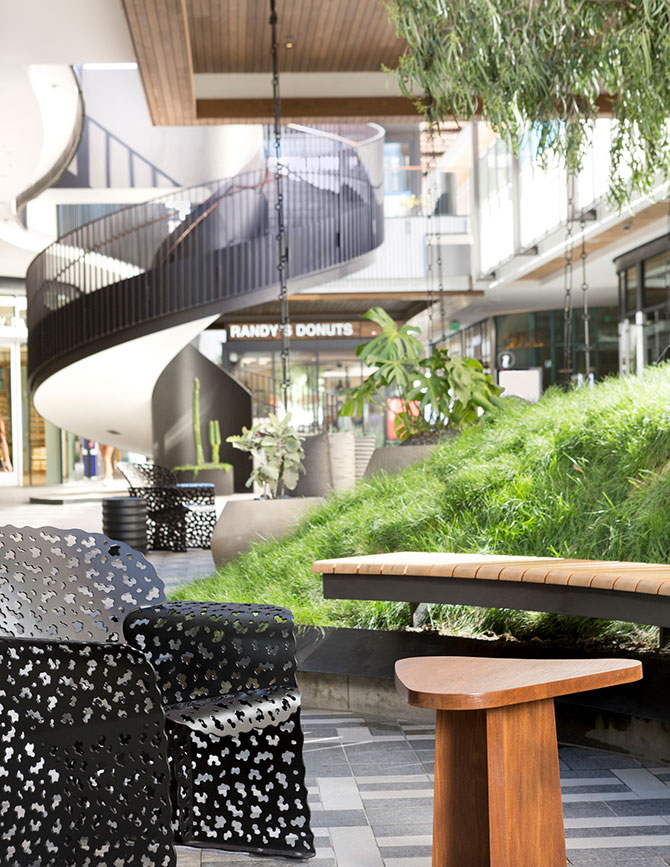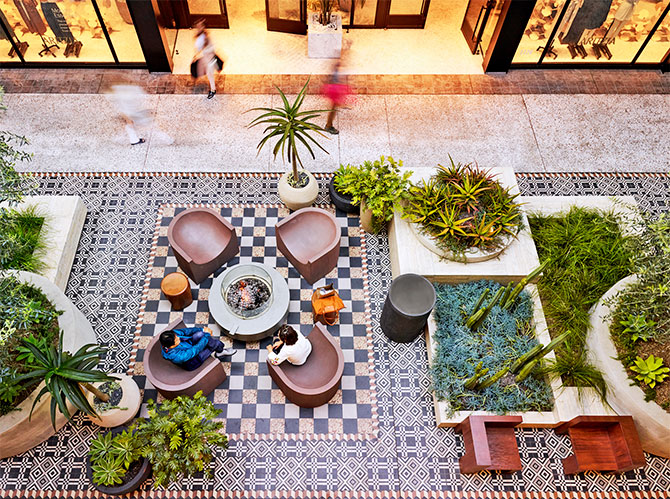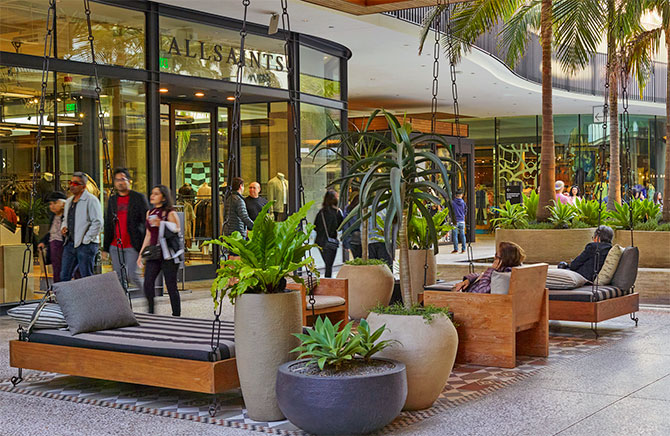
JCK’s ongoing series on the shopping centers finding success amid an ever-changing retail landscape
Westfield Century City
10250 Santa Monica Blvd., Los Angeles
In a town where face-lifts are de rigueur, Westfield Century City got a billion-dollar version. It’s more than ready for its close-up.
The maxim “If it ain’t broke, don’t fix it” has a corollary so obvious it rarely needs to be articulated: If it ain’t broke, don’t spend a billion dollars fixing it. So you might raise an eyebrow at Westfield’s recent $1.1 billion makeover of its flagship mall in Century City, which had hardly become deserted (unlike its soon-to-be-shuttered L.A. neighbor, the beleaguered Westside Pavilion). Westfield Century City had already received a $160 million renovation in the 2000s. And from its very beginning, in 1964, it was an open-air mall, anticipating the urge that seemingly every other mall would feel, come the 21st century, to tear the roof off the sucker. But in the late 2010s, there’s a different conventional wisdom in the mall world: Gut it, or get ghosted.
 The amount of thought that went into the makeover was commensurate with the dollars, all aimed at addressing the dilemma facing any modern L.A. mall operator: how to keep up with the Carusos—that is, the Grove and other popular outdoor shopping complexes developed by impresario Rick Caruso. “This is the first time another mall operator in Los Angeles has been able to meet that very, very high bar,” says Peter Lynch, a retail expert at advisory firm A&G Realty Partners. The Grove and its cousin, the Americana at Brand, were built from the ground up as town-square experiences, like Disneyland’s Main Street USA. Westfield Century City, on the other hand, is not a mall pretending to be a nostalgic small town. The goal, clearly, was to go for full-scale modernism while achieving the kind of cozy tranquility that makes you feel you could spend a few hours reading a book on a swinging couch, working on a laptop in what has to be the world’s most natural wood–filled food court, or communing with friends over the fire pit, in between—incidentally!—visits to some of the world’s choosiest and most exclusive retailers.
The amount of thought that went into the makeover was commensurate with the dollars, all aimed at addressing the dilemma facing any modern L.A. mall operator: how to keep up with the Carusos—that is, the Grove and other popular outdoor shopping complexes developed by impresario Rick Caruso. “This is the first time another mall operator in Los Angeles has been able to meet that very, very high bar,” says Peter Lynch, a retail expert at advisory firm A&G Realty Partners. The Grove and its cousin, the Americana at Brand, were built from the ground up as town-square experiences, like Disneyland’s Main Street USA. Westfield Century City, on the other hand, is not a mall pretending to be a nostalgic small town. The goal, clearly, was to go for full-scale modernism while achieving the kind of cozy tranquility that makes you feel you could spend a few hours reading a book on a swinging couch, working on a laptop in what has to be the world’s most natural wood–filled food court, or communing with friends over the fire pit, in between—incidentally!—visits to some of the world’s choosiest and most exclusive retailers.
The unique space is largely the work of renowned designer Kelly Wearstler, who collaborated with OJB Landscape Architecture and Westfield’s design team. Wearstler, whom The New Yorker called “the presiding grande dame of West Coast interior design,” had never worked on a mall before, which she considered a plus in this revamp.
“Anything seemed possible, since we weren’t hampered by preexisting ideas of what a shopping center should be. Our intention was to make the mall feel residential,” says Wearstler, whose experience with boutique hotels shines through. The desire to make “the interior spaces feel truly and authentically Californian” meant “lush landscaping and really beautiful artisanal materials as well as real materials, such as stone and wood. It speaks of quality, simplicity, and the fact that people are meant to inhabit these spaces.”

The remarkably spacious social corridors feel like an endless series of luxurious but inviting hotel lobbies, filled with wooden modernist chairs, native plants, and grassy knolls. You could almost imagine that high-end commerce came second, were it not for the 1.3 million square feet of retail generating more than $1.25 billion in annual sales. It’s a lovely illusion anyway, with the type A hustle of the shopping experience wrapped up in a curiously relaxing type B feel. Zara, meet Zen bliss.
Is this a luxury mall—Rodeo Drive (Slightly) West, if you will—or a populist city center? Depends on whom you ask. “There are only so many places in the United States that you can do what they did in Century City because the demographics are so unusual,” says Lynch. (He cites Orange County, California’s South Coast Plaza and the Mall at Short Hills in New Jersey among the rare other locations that can afford to reinvent and attract the toniest retailers.) But Westfield is eager to tout the all-are-welcome angle. “The high, the low—there’s something for everybody,” says Louis Schillace, Westfield’s senior general manager. “From the Gap and American Eagle and stores you expect in every shopping center to the unique things such as Compartés chocolates, the representation of the brands here represents the diversity of Los Angeles.” He has a point: Amid the various indie or upscale restaurateurs providing singular experiences, Westfield Century City does have a fairly handsome Chick-fil-A.
What’s really unusual is the number of online-focused retailers, such as Warby Parker and Bonobos, here in the brick-and-mortar flesh. Even Amazon operates a physical bookstore in Century City. Then there are the high-end brands that typically have few or zero storefronts of their own: Take Breitling, which has set up shop on a luxurious curve smack in between Tiffany & Co. and Rolex. “Being the only Breitling Boutique in Southern California, this location sees visitors that are seeking out a visit to a Breitling specifically and have researched the location online prior to their visit,” says Thierry Prissert, president of Breitling USA. “However, we also benefit with visitors that might be stopping by the Apple Store and see the boutique and stop in.” (Even if it’s the rarefied brand of shopper for whom “Breitling” and “impulse buy” occur in the same sentence.)
 Lest the teakwood chairs and native California fauna accents make the mall seem too Edenic, there’s no shortage of tech. Raise your chin above the natural materials and you’ll see a pair of 100-foot-long digital billboards, like something out of Times Square, advertising Kim Kardashian’s pop-up shop. The technological advances start in the parking lot, where you can sign up for an app that will recognize your license plate and open the gate, or reserve a certain spot in advance; you can also text the valet to deliver your car to the opposite end of the mall from where you left it. “We know how important it is in Los Angeles to have a great parking experience,” says Schillace, in what may count as a local understatement.
Lest the teakwood chairs and native California fauna accents make the mall seem too Edenic, there’s no shortage of tech. Raise your chin above the natural materials and you’ll see a pair of 100-foot-long digital billboards, like something out of Times Square, advertising Kim Kardashian’s pop-up shop. The technological advances start in the parking lot, where you can sign up for an app that will recognize your license plate and open the gate, or reserve a certain spot in advance; you can also text the valet to deliver your car to the opposite end of the mall from where you left it. “We know how important it is in Los Angeles to have a great parking experience,” says Schillace, in what may count as a local understatement.
That may be the only catch: You do have to leave at the end of the day, since years ago, locals managed to nix the condo tower once planned to loom over the mall. Westfield is, in its artisanal/billion-dollar way, weirdly homey, but you still have to go home. Fortunately, there are myriad takeout options at Eataly, the Manhattan-born Italian food mall-within-a-mall that many consider Century City’s real marquee attraction. “Anybody that’s a foodie or loves authentic Italian food and experience would fully understand when they go in that place how remarkable it is,” says Eataly’s biggest fan, Lynch, the retail consultant, his mouth almost audibly watering over the phone. As Gershwin might have said: ’S wonderful. ’S marvelous. ’S definitely not Sbarro.
(From top: courtesy of Westfield Century City [2]; Marion Brenner/Courtesy OJB Landscape Architecture [2])